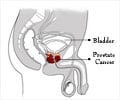Many patients, who are diagnosed with prostate cancer have indolent, slow-growing forms of the disease that are not life-threatening.

Investigators in the Cedars-Sinai Samuel Oschin Comprehensive Cancer Institute have made extensive progress in understanding the molecular mechanisms of disease progression. These results may help scientists better understand the prognosis of patients diagnosed with advanced prostate cancer. The study, published in the journal Cell Cycle and led by Dolores Di Vizio, MD, PhD, may ultimately lead to the development of new biomarkers for not only prognosis, but also a patient's potential response to therapy.
"One of the long-standing difficulties in treating men with advanced prostate cancer has been predicting the response to given therapies or treatments," said Di Vizio, associate professor in the Department of Surgery, Department of Pathology and Laboratory Medicine and Department of Biomedical Sciences. "These latest research findings provide tangible insight into the molecular and structural phenomena that result in prostate cancer metastases. They have the potential to create a new source of biomarkers and an innovative standard of care. These findings may also help distinguish individualized treatment plans best suited for each patient."
The new source of biomarkers is large oncosomes, which are vesicles released from aggressive prostate cancer cells with highly migratory features. These large oncosomes carry tumor molecules and have been shown in previous studies to contribute to tumor progression. This study demonstrates, for the first time in human samples, that identification of circulating large oncosomes can be an indicator of patients with more aggressive, treatment-resistant disease. Also notable, researchers found that large oncosomes contain microRNA, a molecule that regulates several biological processes now proven to influence tumor progression.
At the Cedars-Sinai Urologic Oncology Program, researchers and physicians work in close collaboration to discover personalized options for patients with indolent prostate disease to those with aggressive cancer. This latest study will amplify the genetic and molecular understanding of aggressive prostate cancer.
"Many of the latest research developments and treatments for urologic cancers have been initiated from Cedars-Sinai investigators and physicians," said Robert Figlin, MD, FACP, associate director of the Samuel Oschin Comprehensive Cancer Institute, professor of Medicine and Biomedical Sciences and the Steven Spielberg Family Chair in Hematology Oncology. "These latest research observations may identify novel ways to measure a patient's prognosis and are just a stepping stone for the many discoveries moving down the pipeline in our cancer institute."
 MEDINDIA
MEDINDIA




 Email
Email



![Prostate Specific Antigen [PSA] Prostate Specific Antigen [PSA]](https://www.medindia.net/images/common/patientinfo/120_100/prostate-specific-antigen.jpg)





